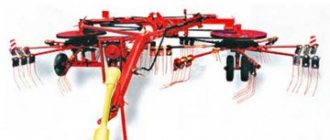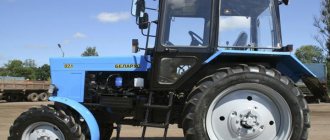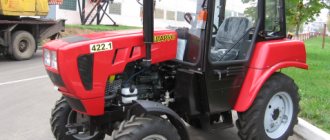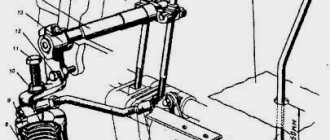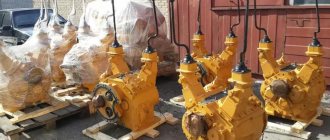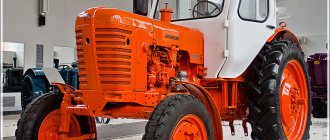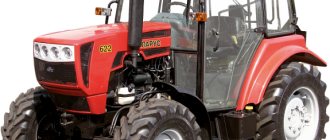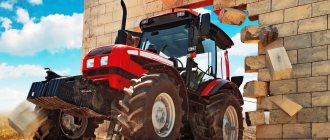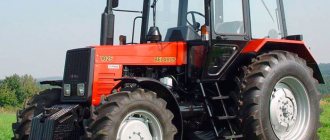Cultivators have recently been increasingly used in fields, displacing traditional plows. Properly selected equipment will allow you to perform more than one operation. We will tell you in this article how to choose a cultivator that will bring maximum benefit to your farmland.
— steam cultivators
— row cultivators
— stubble cultivators
— universal cultivators
- Complete set of pre-sowing cultivators
— ripping paws
— harrows
— rollers
A cultivator, unlike a plow, loosens the soil without turning over the soil layer. In some cases, cultivation with a cultivator can completely replace plowing.
| Only 2-9% of the soil becomes dusty during surface treatment |
How to make a cultivator for a tractor with your own hands?
Modern cultivators for tractors are quite expensive, which is why many farmers prefer to assemble small-sized equipment of this type with their own hands. To make a small structure, you need to prepare the following tools in advance:
- small grinder;
- metal cutting discs;
- welding machine with electrodes:
- double-sided sandpaper with different abrasive sizes;
- drill with a set of drills.
Materials for work you will need:
- square steel plates, approximately 15 x 15 cm in size;
- flat rectangular plates - they will play the role of cutters. The width and length of these parts depends on the tractor model. The optimal cutters are 4 cm wide and 25 cm long;
- 16 pieces of nuts and bolts in pairs;
- long strong steel pipe.
When choosing the materials required for work, it is necessary to take into account that all of them must not only be as durable as possible, but also resistant to corrosion. This need is due to the fact that a tractor-mounted cultivator is often used in conditions of high humidity, which is a strong oxidizing agent and leads to rust on the metal parts of the structure.
To work, you also need to study drawings with dimensions and methods of fastening parts in the structure. The final result largely depends on the correctness of the schemes, so their choice should be treated with special care.
After preparation, you can proceed directly to assembling the cultivator for the garden. The algorithm for its production is as follows:
- At the very beginning of assembly, you will need to drill one hole in each rectangular and square metal plate;
- Next, the plates need to be aligned so that there is one cutter on each side of the square. They can be attached to the base using suitable bolts;
- If there are no bolts, the parts can be welded to each other. This kind of connection will be less reliable, which is why cultivating the soil with a tractor will be possible only in areas with loose soil. However, a mounted cultivator must have maximum strength, since it is often used for plowing hard soil, during which the cutter and the base of the structure are subject to the heaviest loads;
- After aligning the plates, you will need to make a hole in the center of the equipment through which you need to insert a metal tube;
- The tube needs to be cut into two identical parts, on each of which you will need to put a platform with cutters. The latter can be secured by bolts or welding;
- Next, you need to connect both parts of the cultivator to the tractor's power take-off shaft. To do this, it is best to use a drill and several suitable bolts;
- The tractor shaft and tube with cutters will need to be drilled through. The drilling area depends on the tractor model. For example, if the farm uses a Zetor tractor or other large-sized machines, then you will need to drill a hole closer to the center of the PTO of the unit. After this, all the holes need to be aligned, and a bolt must be inserted through them, onto which you need to put a nut and a lock nut. The video will tell you in detail about the manufacture of a cultivator for a tractor.
https://youtube.com/watch?v=hN2c2lj8uxM
Popular models
The T-25 is a rear-wheel drive lightweight tractor, the front wheels of which are smaller in size compared to the rear ones. The vehicle is equipped with a two-cylinder, four-stroke, air-cooled diesel engine. The reversible manual transmission has the ability to be combined with attachments. Thanks to this, cultivators and other devices that make the worker’s work easier are hung on the T-25.
For coupling with the T-25, a cultivator-hiller with pointed or loosening tines is ideal. The device can be supplemented with a weeder, which is suitable for removing weeds. The unit can process row spacing from 62 to 75 cm wide.
In addition to the hiller, the T-25 can be equipped with a continuous and pre-sowing cultivator for soil cultivation, which will provide simultaneous harrowing. The KON-1.4 product is equipped with toothed (spring) harrows that provide high-quality loosening to the selected depth while simultaneously getting rid of weeds.
The attachments are combined with a hydraulic frame, which allows the transport width to be reduced to four meters - this eliminates the need for additional equipment to deliver a hitch from several cultivators.
Other popular cultivator models:
- KPS-4 – steam;
- KRN-5.6 – inter-row;
- KPM-8 – pre-sowing;
- KRG-3.6 – hydroficated.
The devices are designed to treat areas from 4 to 10 hectares.
T-40 is a wheeled tractor that rolled off the assembly line of the Lipetsk plant in 1961. The reliability and improved characteristics of the product turned it into a bestseller in Soviet mechanical engineering.
A rotary cultivator or rototiller will work successfully in conjunction with the T-40. The unit is used for cultivating virgin lands. The T-40 with a rotary cultivator copes with fields where corn grew. This culture is considered a good green manure. A rotary cultivator will not only efficiently chop plant residues, but also ensure their mixing with the soil.
Content:
Growing crops involves a whole range of work throughout the year - from cultivating the soil for crops to harvesting crop residues. To solve these problems, a whole fleet of equipment or manual labor was previously used, but the first method is not profitable from an economic point of view, and the second is ineffective. However, now farmers can use cultivators that do not have these disadvantages to process crops.
Types of replacement attachments for cultivators
A cultivator for a motor tractor can be equipped with various attachments.
They are divided into several types:
paws - necessary for plowing the soil while simultaneously removing weeds. There are several types of these nozzles. Chisel-shaped devices are designed for loosening the soil to a depth of 15 cm. Lancet universal paws are used for continuous or inter-row plowing of soil to a depth of 14 cm. Devices of this type do a good job of chopping soil and cutting weeds. Single-sided flat-cutting paws are intended exclusively for cutting large weeds;
- harrows - nozzles of this type are used for processing the soil between rows and in protective zones;
- Feeding knives – used for loosening the soil between rows and simultaneously incorporating fertilizers into the soil. The maximum working depth is 16 cm;
- needle discs - designed to destroy the earth crust and destroy weeds. The processing depth is 4 cm, and the soil shift is 1–2 cm;
- Hillers - these attachments are used for cutting ridges and destroying weeds between rows. Maximum processing depth – 16 cm:
- furrow cutters - used to prepare furrows for further irrigation. The depth of the furrows does not exceed 20 cm.
All replaceable attachments are fixed on the cultivator stands using a bolted connection. To extend the life of your equipment, you should regularly clear it of weeds and avoid contact with soil that is too wet.
This is interesting: Features and characteristics of the Italian tractor lamborghini r2 (Lamborghini r2)
conclusions
It would seem that, taking into account the functionality, the walk-behind tractor definitely looks better than a cultivator, even if the second unit is equipped with a variety of additional body kits. But in practice, cultivators are widely used, otherwise they would simply be discontinued.
*{padding:0;margin:0;overflow:hidden}html,body{height:100%}img,svg{position:absolute;width:100%;top:0;bottom:0;margin:auto}svg{ left:calc(50% - 34px)}
» frameborder=»0″ allow=»accelerometer; autoplay; encrypted-media; gyroscope; picture-in-picture» allowfullscreen>
The cultivator is more compact and copes well with loosening the soil, fluffing it up. For working in a greenhouse, in a small area where there is simply no room for a walk-behind tractor to turn around, a cultivator with a gasoline or electric motor is more convenient. Therefore, for small areas where the land never sits idle, a cultivator can be recommended.
Popular models
The modern market offers a large number of cultivators that can be mounted with MTZ tractors. Among them there are both models of Russian and Belarusian production, as well as guns from well-known European and American manufacturers. Below are some popular samples, reviews of which are most common. KPS-4
KPS-4
The model is an indispensable assistant for high-speed steam treatment; it allows for pre-sowing soil preparation without crushing plant residues. The gun is of the lancet type and can be operated at speeds of up to 12 km/h. The productivity of the device is 4.5 ha/h, the working surface working width reaches 4 m. The model is equipped with knives with a width of 20, 27 and 30 cm, capable of cutting into the soil to a depth of 12 cm.
The implement can be mounted with MTZ level 1.4 tractors. It is available in both mounted and trailed versions. The weight of the structure is 950 kg. The transfer to the transport position is carried out hydraulically. The ground clearance is 25 cm, the recommended speed on public highways is 20 km/h.
KPS-5U
This cultivator is intended for continuous cultivation of the land. It is capable of being aggregated with MTZ tractors of levels 1.4-2. The model is used when caring for couples. It is capable of effectively performing pre-sowing tillage with simultaneous harrowing.
The design of the implement is represented by a reinforced all-welded frame, for the manufacture of which a metal profile with a thickness of 0.5 cm and a section size of 8x8 cm is used. The 1.4 cm thick bed slats are reinforced, and thanks to the expanded surface of the bypass beam, the possibility of clogging the wheels with plant debris and clods of earth is eliminated.
The working width of the unit reaches 4.9 m, productivity is 5.73 ha/h, processing depth is 12 cm. The implement weighs 1 ton, the recommended transportation speed is 15 km/h. The model is equipped with ten cutting elements with a width of 27 cm and the same number of paws with a cutting edge of 33 cm.
Bomet and Unia
Of the foreign models, one cannot fail to note the Polish cultivators Bomet and Unia. The first is a traditional soil cutter capable of breaking up blocks of earth, loosening and mixing the soil, as well as cutting off the stems and rhizomes of grass. The implement is mounted on the MTZ-80 tractor, has a working width of 1.8 m, and can be used not only for field work, but also for garden work.
The Unia model is fully adapted to the harsh Russian climate. It is one of the most popular in the domestic market. The implement is used for loosening, plowing and mixing soil, has a working width of up to 6 m, and is capable of going 12 cm deep into the soil. The company’s product range includes disk and stubble models, as well as implements for continuous tillage.
For a detailed review of the KPS-4 cultivator, see the following video.
Description
A tractor cultivator will cultivate the soil without disturbing the fertile layer. The device will also cope with weeds. A tractor hitch will prevent soil erosion. It is equally in demand both on large-scale cultivated areas and on small home plots. The main advantage of the mini-tractor is its passive control mode.
Due to its ease of operation, the equipment is currently in great demand. The choice of mini-devices is complicated by the variety of machine performance characteristics - models are capable of performing a variety of functions. The cost of products is closely related to functionality.
Simple garden cultivators consist of a mechanically controlled engine and parts that cultivate the soil. Cultivation of a vegetable garden is possible with an electric or gasoline power unit, requiring an operator, whose role can be played by any person. The dimensions of the treated area vary according to the working width of the device from 30 to 80 cm.
In contrast, conventional classic machines with a trailed cultivator, which cultivate strips up to 3 m wide, are equipped with active operating systems. They are driven by hydraulics. The designs are complemented by driven cutting elements. Conventional trailed cultivators operate using the traction force of the tractor. They are simple structures connected to the device by coupling mechanisms.
In addition to trailed cultivators, hitches are connected to tractor equipment. For them, a basic chassis, which is combined with traction, is sufficient. The frame is equipped with elements of various shapes. The working mechanisms of the hitch are driven by the tractor's power take-off. Support wheels allow you to set the cultivation depth.
Different forms of working mechanisms allow for loosening, making furrows, hilling or working with fertilizers. To transport the cultivator to the work site, you need a hydraulic drive powered by the base chassis system. The tractor with the cultivator is controlled by a machine operator, who must obtain the appropriate knowledge and have permission to work.
Geometric design parameters
If you want to make a plow with your own hands, pay attention to such important indicators as the size and shape of the cutting part. They determine the efficiency of immersion of the unit into the soil and the volume of processed land.
If plowing is being done, the plow should not go out or dig too deep into the ground, go sideways or deviate from the intended path. Key design properties that require increased attention are the following:
- the angle of the edge that enters the ground;
- the angle of bending of the blades.
A good edge angle ensures easy entry of the device into the soil and fixation of the desired position. In most cases it stays at around 40 degrees. If the angle is too sharp, the plow slips out, and if the angle is large, it simply cannot solve the assigned tasks. As a result, the ground will begin to get stuck. The bend of the blade affects the table turn, or blade angle. It’s easy to guess that the larger the blade, the more land it can process at a time. True, in this case the load on the minitractor increases. The best inclination angles are degrees from 25 to 130.
As for the working part of the plow, it uses a ploughshare that can take on the main load. It is made of durable thick-sheet steel. As for the shape, it can be cylindrical, semi-cylindrical or helical. The bending angles correspond to the blade angles. The holder mount is attached to the share.
Cultivator location
To do this, use a marking plate or a flat surface with a hard surface. The width of the slab should be 0.5−1 m larger than the working grip of the cultivator. The longitudinal center line of the ON unit is drawn on the slab. The axial lines mm of rows of plants and the boundaries of protective zones are marked with chalk, (shaded) at a distance A from the axis of the row. If the cultivator will process an even number of rows in one pass, then lines mm are drawn from the ON axis on the right and left at a distance equal to half the row spacing b/2, and then at a distance b. If there is an odd number of rows, lines mm are drawn from the center line ON of the cultivator at a distance equal to the row spacing b.
The unit is installed on the marking plate so that the middle of the cultivator beam, point C, is located above the middle of the plate, point N. The tractor's attachment is positioned parallel to the platform, and the hitch post is positioned vertically.
Scheme of arrangement of working parts on the cultivator: I - for cutting weeds; II - for loosening and cutting weeds; III - for deep loosening; IV - for hilling plants; V - for feeding and hilling; 1 - one-sided weeding paws; 2 - lancet lindens; 3 — loosening paws; 4 - hilling bodies; 5 feeding knives.
On the cultivator beam, chalk marks the places where the sections are attached. If there is an even number of rows being processed, the middle section is fixed at point C, and the next ones at a distance B equal to the row spacing. The symmetry axes of the beams and section wheels pass in the middle of the row spacing, along the center lines of the OO.
Classification of cultivators for MTZ 82(80)
Tillage devices are divided into groups taking into account the method of aggregation and the type of operations performed.
According to the method of connection to the tractor, processing machines are divided:
- Trailed - connected through the trailer hitch of the tractor's rear linkage. Raising and lowering of the working parts is carried out by an external hydraulic cylinder as part of a trailed cultivator. Due to the presence of a chassis in the design of the cultivator, the advantage of a trailed unit is a balanced load on the tractor axles.
- Mounted – rigidly connected to the three-point hitch of the tractor. The position of the unit is shifted by a hydraulic cylinder of the rear linkage of the tractor. The mounted unit has significantly smaller dimensions, which increases its maneuverability.
As a rule, manufacturers of agricultural equipment produce analogues of mounted machines in a trailed version in case of justified consumer demand.
The equipment is divided according to intended use:
- Cultivators for continuous tillage are used for pre-sowing soil preparation, steam treatment and post-harvest stubble peeling. Depending on the design of the device, they can be connected to the tractor in both mounted and trailed versions.
- Cultivators for inter-row cultivation of crops are used for row crops with the possibility of simultaneously feeding crops with mineral fertilizers. The devices are distinguished by mounted aggregation, since the rigid connection to the tractor ensures strict movement of the working elements in the processed inter-row area.
- The group of special-purpose cultivators includes devices used in certain types of work, such as soda and vineyard cultivators. The devices are distinguished by reinforced working bodies capable of processing turfy and woody soils. Additionally, cultivators can be equipped with active chopping elements for mulching branches and weeds.
Features of the design and use of walk-behind tractors
Walk-behind tractors are equipped with gasoline and diesel engines and are divided into:
- light - with engines up to 6 hp,
- medium - up to 8 hp,
- heavy - from 8 or more horsepower.
The main difference between a walk-behind tractor and a cultivator, as noted above, is the presence of a power take-off shaft, on which various attachments are placed for a variety of gardening work.
If you have the appropriate equipment, the walk-behind tractor can be used for:
- plowing, hilling, row-spacing,
- mowing,
- hilling, digging potatoes,
- snow removal.
Since the walk-behind tractor is equipped with a gearbox, it can also be used as a vehicle; it is enough to get a towed trolley if it is not included in the package.
The delivery package of a walk-behind tractor does not always include attachments. Depending on the tasks solved with its help, you will need active cutters (may be included in the delivery package), a plow, a potato digger, a hiller, and a cart.
Compared to a cultivator, a walk-behind tractor has more weight, but at the same time a more durable frame and a powerful motor. In addition, the walk-behind tractor is always equipped with wheels and tires.
You should buy it if not only soil cultivation is important, but also other types of work, and the site has a sufficiently large area on which there is room for a powerful unit to deploy.
A heavy walk-behind tractor actually has the functionality of a mini tractor, but it also has the appropriate dimensions.
Principle of operation
The transverse frame beam rests on wheels, five working compartments and sowing devices of fertilizer configuration are fixed on it. To interact with the tractor, an automatic coupling lock is used, which is welded to the frame beam. The working section is a parallelogram mechanism with four links. It consists of a front bracket, a link in the shape of the letter “P”, an upper adjustable analogue, and a beam. The last element holds: a working holder, a support wheel frame, and two side elements.
The sections are rearranged along the frame, which makes it possible to process row spacing with a width of 0.6-0.7 m. The main parallelogram mechanism on the ups and downs of the wheel and on uneven ground guarantees uniform movement of the beam, maintaining constant angles of the working bodies in depth and inclination.
What is a “mini tractor” and what are its differences from the classic one?
The power of the mini tractor is enough for a medium-sized garden or garden; it is also ideal for farms and small private farms.
The difference is not only in size, but primarily in the traction class. Mini tractors are inferior to traditional models in weight and, accordingly, power. Therefore, their cost is significantly lower, and they also consume less fuel and have less expensive parts.
With the help of a mini tractor you can:
- Remove snow, construction debris, branches, leaves, etc.
- Uproot stumps.
- Plow the ground.
- Clear outbuildings.
- Correct the road level.
- Patch the asphalt.
- Cover the lawn.
- Mow the lawn.
- Irrigate the land.
- Apply de-icing agents or fertilizers.
- And much more.
Famous manufacturers
There is a large selection of such equipment on sale. It is produced by different manufacturers. Cultivators from Champion, Texas, MTD, Husqvarna, Caiman, Viking, etc. are in demand. The leading places in the ranking of manufacturers are occupied by companies from the USA and Europe.
However, domestically produced products are also in demand in our country. The most popular is the Russian brand Elitech. This manufacturer's line includes many light, medium and heavy models. The cost of domestically produced products is reasonable and the quality is high. This makes the presented company popular and in demand.
If you want to save money on your family budget, but at the same time purchase foreign-made equipment, you should pay attention to Champion cultivators. They are produced by the USA together with China. Texas is also known for its reasonable price and decent quality. Its products are produced by Denmark jointly with China.
When choosing a cultivator manufacturer, you should give preference to well-known, proven brands. They are constantly improving their products. The quality of the equipment in this case will be much higher.
Having considered what a cultivator is, its features and varieties, every owner of a summer house or personal plot will be able to choose the best option for himself.
Popular models
Cultivator "Texas"
There are a number of models that are widely popular:
- The KPS-4 model is a steam cultivator that is used by class 1.4 tractors. Designed to move at a speed of 12 km per hour. Can be used on an area of up to 4.5 hectares.
- The KRN-5.6 cultivator is an inter-row device. Suitable for working with tractors of class 1, 4 or 2. The cultivator is adapted for working with long-stemmed and essential oil crops.
- KPM-8 – designed for pre-sowing treatment. It works at high speed: in one hour it is capable of processing a field occupying 10 hectares.
- KRG-3.6 is a device with pointed arms that is hydraulically powered. It is usually used in areas that have a small area.
- KON-2.8. This cultivator model has a hilling function. It can be used when planting potatoes. At the same time, he can additionally fertilize with fertilizers.
Cultivator KRN
Other models are also widely known, for example: Wheel Rich, KNK, Salford, KPSh, Champion, Cayman.
Number of speeds
Self-propelled cultivators are equipped with different types of transmissions. The direction of movement of the unit and the number of speeds depend on this. Manufacturers produce cultivators with the following transmissions:
- 1 speed. Used in the simplest and cheapest models. If you need to go back or move the device, you will have to do it manually.
- 2 speeds. One forward and one reverse speed provides the unit with excellent performance in small areas.
- 4 speeds. If the unit can operate at 2 forward and 2 reverse speeds, there should be no problems with turns when working in difficult areas. Such models effectively shake off debris and long, entangled roots from the cutters.
- 4 speeds. Another design – 3 forward speeds and 1 reverse. This option is implemented in multifunctional cultivators designed to perform various operations on land plots.
The presence of several speeds simplifies the operation of the cultivator. But it should be taken into account that the more speeds, the more complex the transmission, the more demanding it is to maintain and the more prone to breakdowns it is.
About this device
Cultivators, of different designs and different specifics of work, are precisely the equipment that is rarely used, but brings great benefits.
It’s not in vain that the most popular product drawings are a homemade cultivator for a walk-behind tractor and a homemade hiller cultivator. They are relatively easy to make yourself, at home, so there are a lot of variations of schemes on this theme.
The principle of operation and purpose of homemade cultivators is the same as that of industrially produced Patriot, Champion, Swift, Texas, Viking, Cayman cultivators.
Next, we will look at the most successful and simple options for homemade cultivators. Also see the articles “do-it-yourself harrow for a walk-behind tractor, drawings” and disk hillers for a do-it-yourself walk-behind tractor.
For more information about the operation of the cultivator, watch the video:
This is interesting: Review of kubota mini tractors
Location of working bodies
When preparing the cultivator for work, the working parts are placed along the intended rows so that the edges of the blades closest to the row of paws pass from the axis of the row at a distance equal to the width of the protective zone A.
For complete cutting of weeds, pointed paws and razors are installed in row spacing with an overlap of 3-7 cm. Chisel-shaped paws, loosening a strip of soil wider than their grip, are placed without overlap.
When installing several working bodies on sections, they are distributed in a checkerboard pattern along the length of the beam so that the gaps between the ends of the wings of adjacent paws are at least 3 cm, for the passage of soil and plant residues. Chisel-shaped paws are secured to the beam at the maximum distance between each other. A hilling body is installed on the beam, closer to the section wheel, which improves good copying of the row spacing. On the last sections, one or two paws are mounted, since the butt row spacing is processed in two passes.
In order to set the working bodies to a given processing depth, blocks of the same thickness are placed under the wheels of the sections as under the wheels of the frame. Place the length of the upper link of the parallelogram mechanism, the beam section, parallel to the platform. The working bodies are arranged and secured so that the cutting edges of the pointed paws and razors are in contact with the plate, and the chisel-shaped paws rest on it with their toes. If the link is too short, the paws will rest on the toes.
Accordingly, the mixing of the loosened layer will increase, the cutting of weeds will worsen, the covering of plants with soil will increase, and the bottom of the furrow will be wavy. If the link is excessively lengthened, the paws will move “on their heels” and will not deepen enough.
If working tools are installed on sections for working at large or small depths, then the height of the pads under the support wheels of the timber and the wheels of the sections will be the maximum working depth, reduced by 2-3 cm, to the depth of immersion of the wheels in the soil. Working bodies, when working with the greatest depth, are placed on the platform. Under the working bodies working at a shallower depth, pads are installed with a height equal to the difference in the depth of processing with the first and second paws.
Pre-sowing tillage
The models of cultivators from various manufacturers on the market have a lot of conceptual differences, which at the same time make it possible to optimally select a machine in accordance with the needs of a particular farm, says Vyacheslav Veklenko, representative for the Southern Federal District of Horsch
.
— Of the entire group of cultivators, the pre-sowing cultivator is the lightest machine.
The functions of pre-sowing cultivators include leveling and improving the water-air regime, that is, creating conditions for plant respiration through light loosening and creating a fine-lumpy soil structure. As a rule, light pre-sowing cultivators are used before sowing industrial crops, spring row crops and grains (to a limited extent) .
If we are talking about preparing the soil for sowing row crops, then, in our opinion, traditional tine cultivators do an excellent job,” continues Vladimir Kudryavtsev, head of the advertising and marketing group of the sales department of JSC PC Yaroslavich.
. —
Row crops, especially sugar beets, place increased demands on the quality of tillage - both crumbling and uniformity of depth. Even slight fluctuations up or down when planting seeds of corn, sunflower or sugar beets will certainly affect the uniformity of seedlings
.
